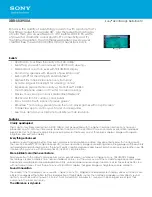
CF 126
4
Nov 2001
The instrument enters its INITIALIZE mode that lasts a few seconds per channel. When the instrument
enters its normal operating mode (RUN mode), you will see the following format on the front panel
display:
1
c
ØØØØØ
. PSIG
◊
2.5 Configure a Terminal Emulator Program
Start your favorite terminal emulator program. Configure it to communicate with the serial port you have
connected the instrument to (usually COM1 or COM2), at 9600 baud, no parity bits, 8 data bits and 1 stop
bits ("9600,8,N, 1"). Disable any hardware or software handshaking or flow control such as (RTS/CTS
handshaking, DSR/DTR handshaking or Xon/Xoff flow control.
2.6 Establish Communications
The following examples assume that the two-character address of the instrument is the factory default of
"00" (ASCII code decimal 30, ASCII code decimal 30).
2.6.1 Example 1
All instruments will respond to the "RR: Read Revision" command. Type the following command into your
terminal emulator software, followed by the Enter key:
#00
RR
↵
You should see a reply from the instrument similar to:
084-1500-01 2.07
2.6.2 Example 2
The "FI: Display Characters" command can be used to send a message to the instruments display. For
example, type the following command into your terminal emulator program:
#
00FIHELLO, WORLD
↵
The instrument will acknowledge with "OK" and the characters "HELLO, WORLD!" III should be displayed
on the instrument's front panel.
Chapter 3 Command Format
3.1 Introduction
All DFI instruments have a standard DB-25 type female connector that is used for both serial
communications and other control functions. One of two communications hardware interfaces is available:
RS-232 or RS-485. Instruments equipped with the RS-485 two-wire interface can also be used in an RS-
422 four-wire type setup; thus this interface is sometimes called RS-422/RS-485. Regardless of the type
of hardware interface used, the SC uses the same software command set, the general format of which is
described in this chapter.
3.2 Baud Rate, Start Bits, Stop Bits and Parity
DFI Instruments always use 8 data bits, one start bit and one stop bit and no parity bits (often described
as "N81 ") for serial communications. Baud rates of 300, 1200, 2400, 4800, 9600, 19200 or 38400 baud
are available. As shipped from the factory, DFI Instruments are set to communicate at 9600 baud. The
baud rate can be viewed from the front panel but can only be changed over the serial communications
link. For details on changing the baud rate, see "W1 Write Baud Rate".
3.3 Differences between Instruments
The commands described in this guide may not be available on all versions of DFI series instruments.
For example, since the model DFI 1550 does not have "limits" or "peak/valley" functions, commands
Содержание DFI 1550
Страница 1: ...DFI 1550 1650 COMMUNICATIONS GUIDE...








































